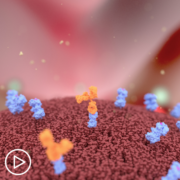What Is the Ann Arbor Staging System for Diffuse Large B-Cell Lymphoma?
What Is the Ann Arbor Staging System for Diffuse Large B-Cell Lymphoma? from Patient Empowerment Network on Vimeo.
What is the diffuse large B-cell lymphoma (DLBCL) system called Ann Arbor staging? Expert Dr. Nirav Shah from the Medical College of Wisconsin explains how DLBCL differs from other blood cancers and symptoms that characterize each DLBCL stage.
Dr. Nirav Shah is an Associate Professor at the Medical College of Wisconsin. Learn more about Dr. Shah.
[ACT]IVATION TIP:
“…make sure they really understand their scan and what stage they are, and how that impacts the treatment that the doctor is offering.”
See More from [ACT]IVATED DLBCL
Download Resource Guide en español
Related Resources:
Transcript:
Lisa Hatfield:
I know as a blood cancer patient, my number one question is, what stage do I have and what is my prognosis? So can you explain the staging system a little bit, I think it’s called the Ann Arbor staging system for DLBCL and then maybe prognoses that you may or may not feel comfortable giving to each patient.
Dr. Nirav N. Shah:
Yeah, so lymphoma is a little bit different, because it’s a blood cancer that involves lymph nodes, and so how we stage it is based on the location and the number of lymph nodes involved, if, for example, you had one lymph node in your neck, and that’s all you had, we would consider you to have stage I diffuse large B-cell lymphoma. If you had more than one lymph node, but on the same half of the body, thinking of your diaphragm as sort of a midpoint, we would then consider you to have stage II disease. If you have lymph nodes on both halves of the body, we would then consider you to have stage III disease, and if you have organ involvement, so bone marrow involvement, liver involvement, kidney involvement or lung involvement, we consider those patients to be stage IV.
Now, to a certain degree, the higher the stage, the worse the prognosis, but as I stated earlier, even patients with stage IV lymphoma can be cured, and that’s different than other cancers, right? When we think about stage IV colon or stage IV breast, many of those patients, we actually tell them that they’re in a non-curative setting, and so while the prognosis for stage III and IV is a little bit worse than those patients who have stage I to II disease, I do try to focus on that we do treat with curative intent, and we do alter our treatment regimens according to the stage of disease that they present with, and so my activation tip for patients in this setting is to make sure they really understand their scan and what stage they are, and how that impacts the treatment that the doctor is offering.
Share Your Feedback:
Create your own user feedback survey









